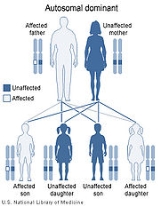
De Vivo disease
Encyclopedia
De Vivo disease is an autosomal dominant developmental disorder associated with a deficiency of GLUT1
also known as Glucose transporter type 1 deficiency syndrome (Glut1-DS)

, mental and motor developmental delays, infantile seizures refractory to anticonvulsants, ataxia
, dystonia, dysarthria, opsoclonus, spasticity, and other paroxysmal neurologic phenomena. Mothers of infants with this disorder usually have uneventful pregnancies and deliveries, with the child appearing normal and with in typical birth weight and length ranges. Infants with GLUT1 deficiency syndrome have a normal head size at birth, but the growth of the brain and skull is slow, in severe cases resulting in an abnormally small head size. Typically, seizures start between one and four months in 90% of cases with abnormal eye movements and apneic episodes preceding the onset of seizures in some cases. Seizures usually are complex to begin with and later become more generalized. Seizure frequency is variable and a history of decreasing frequency during times of ketosis
may prompt a diagnosis. Developmental delays are often global and include receptive and expressive language dysfunction.
glucose value, (<2.2 mmol/L), or lowered CSF/plasma
glucose
ratio (<0.4), erythrocyte 3-O-methyl-d-glucose uptake assay. Once diagnosed, a Ketogenic diet
is usually recommended as it helps to control seizures by providing ketones as an alternative fuel source for the brain other than glucose.
Seeing that the ketogenic diet was discovered as a way to reduce seizures long before 1991 when De Vivo was first diagnosed, it is speculated that some of the ketogentic diet's success was because the children who experienced success on the diet actually had De Vivo at a time when the disease was not yet understood. Less thatn 100 cases have been identified since it's discovery.
GLUT1
Glucose transporter 1 , also known as solute carrier family 2, facilitated glucose transporter member 1 is a protein that in humans is encoded by the SLC2A1 gene...
also known as Glucose transporter type 1 deficiency syndrome (Glut1-DS)

Presentation
De Vivo disease is characterized by deceleration of head growth also known as microcephalyMicrocephaly
Microcephaly is a neurodevelopmental disorder in which the circumference of the head is more than two standard deviations smaller than average for the person's age and sex. Microcephaly may be congenital or it may develop in the first few years of life...
, mental and motor developmental delays, infantile seizures refractory to anticonvulsants, ataxia
Ataxia
Ataxia is a neurological sign and symptom that consists of gross lack of coordination of muscle movements. Ataxia is a non-specific clinical manifestation implying dysfunction of the parts of the nervous system that coordinate movement, such as the cerebellum...
, dystonia, dysarthria, opsoclonus, spasticity, and other paroxysmal neurologic phenomena. Mothers of infants with this disorder usually have uneventful pregnancies and deliveries, with the child appearing normal and with in typical birth weight and length ranges. Infants with GLUT1 deficiency syndrome have a normal head size at birth, but the growth of the brain and skull is slow, in severe cases resulting in an abnormally small head size. Typically, seizures start between one and four months in 90% of cases with abnormal eye movements and apneic episodes preceding the onset of seizures in some cases. Seizures usually are complex to begin with and later become more generalized. Seizure frequency is variable and a history of decreasing frequency during times of ketosis
Ketosis
Ketosis is a state of elevated levels of ketone bodies in the body. It is almost always generalized throughout the body, with hyperketonemia, that is, an elevated level of ketone bodies in the blood. Ketone bodies are formed by ketogenesis when the liver glycogen stores are depleted...
may prompt a diagnosis. Developmental delays are often global and include receptive and expressive language dysfunction.
Genetics
The gene that is involved in this disorder, SLC2A1, provides the code that produces the protein known as the glucose transporter protein type 1. This protein is used in transporting glucose across the blood-brain barrier.Effects
The disease causes infantile seizures refractory to anticonvulsive drugs, developmental delay, acquired microcephaly and neurologic manifestations including spasticity, hypotonia, and ataxia.Diagnosis and treatment
De Vivo is diagnosed with CSFCerebrospinal fluid
Cerebrospinal fluid , Liquor cerebrospinalis, is a clear, colorless, bodily fluid, that occupies the subarachnoid space and the ventricular system around and inside the brain and spinal cord...
glucose value, (<2.2 mmol/L), or lowered CSF/plasma
Blood plasma
Blood plasma is the straw-colored liquid component of blood in which the blood cells in whole blood are normally suspended. It makes up about 55% of the total blood volume. It is the intravascular fluid part of extracellular fluid...
glucose
Glucose
Glucose is a simple sugar and an important carbohydrate in biology. Cells use it as the primary source of energy and a metabolic intermediate...
ratio (<0.4), erythrocyte 3-O-methyl-d-glucose uptake assay. Once diagnosed, a Ketogenic diet
Ketogenic diet
The ketogenic diet is a high-fat, adequate-protein, low-carbohydrate diet that in medicine is used primarily to treat difficult-to-control epilepsy in children. The diet mimics aspects of starvation by forcing the body to burn fats rather than carbohydrates...
is usually recommended as it helps to control seizures by providing ketones as an alternative fuel source for the brain other than glucose.
Seeing that the ketogenic diet was discovered as a way to reduce seizures long before 1991 when De Vivo was first diagnosed, it is speculated that some of the ketogentic diet's success was because the children who experienced success on the diet actually had De Vivo at a time when the disease was not yet understood. Less thatn 100 cases have been identified since it's discovery.

